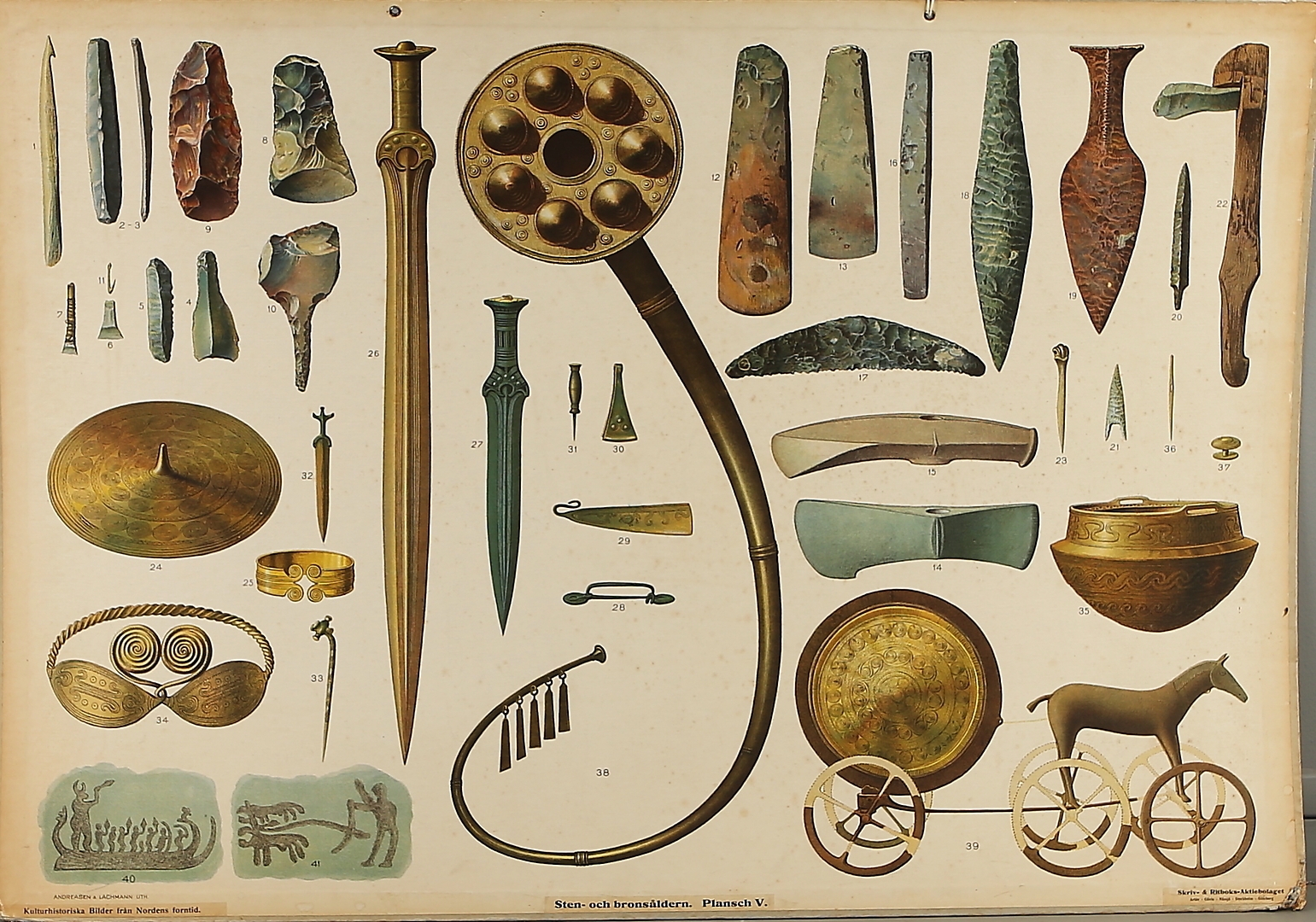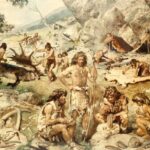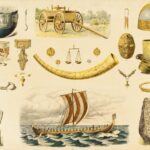The Bronze Age dawns
Commencing approximately 3300 BC in the Fertile Crescent, the Bronze Age is the second of Christian Jürgensen Thomsen’s “Three Age System”, following the Stone Age and preceding the Iron Age. It was not the first use of metal in Eurasia: for several millennia prior to this, Neolithic peoples in Europe had been using copper in a limited capacity. However, its use was still quite limited, and so this period—sometimes called the “Chalcolithic”—is usually considered a subdivision of the Neolithic, or Late Stone Age. It was only when metallurgists figured out that copper alloyed with tin or, less commonly, arsenic produced a vastly stronger and more useful metal that these peoples began to properly move out of the Stone Age. Bronze technology and manufacture spread rapidly and unstoppably—the age of metal had begun.
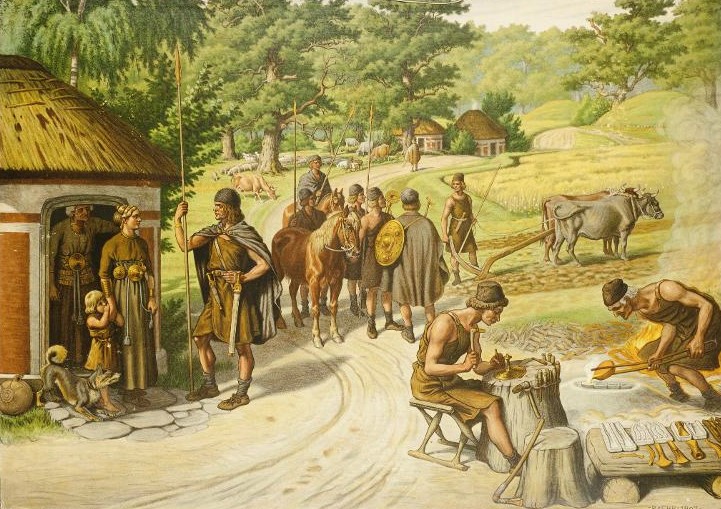
Disparate cultures across Bronze Age Europe, even those separated by wide distances such as the Klokkeberg culture (2350–1700 BC), the Tumulus culture (1600–1200 BC), and the Únètice culture (2300–1600 BC) showcase their own distinct cultural traditions but they also share many very similar findings. This may indicate that there may have been close communication between the groups and that trade networks were becoming longer, and more regular, than they had during the Stone Age. The Klokkeberg culture, in particular, has previously been described as traders and explorers, and it is possible that they played a large part in maintaining this network. They were also one of the instrumental cultures in bringing bronze to Scandinavia.
The Nordic Bronze Age
The Nordic Bronze Age arrived quite late compared to the rest of Europe—roughly 1600 years behind, around 1700 BC. This is thought to be primarily an issue of materials. Neither of the base metals for manufacturing bronze were readily available from native sources in Scandinavia at this time—thus, it was not only the art of mixing them but also the raw materials themselves that needed to be imported. These initially came to Scandinavia by way of migrant Indo-European speakers, but throughout the Nordic Bronze Age Scandinavia would form trade routes for acquiring the metal that stretched throughout Europe, all the way to Mycenaean Greece.
By the end of the Stone Age, Scandinavians were importing bronze from the continent on large scales to make tools and jewelry through molding, and a distinctive metalworking culture developed. However, a common misconception about the Bronze Age is that people stopped using stone, wood, and bone altogether as craft material for their tools, making a wholesale switch to bronze. This is in fact incorrect; these materials continued to form the primary Scandinavian toolkit for centuries to come. Again, the reason for this is that bronze needed to be imported, thus it was primarily reserved for the elite people of the society who had the means to acquire it. Its rarity made it impractical for replacing readily available materials like flint.
The period is usually divided into two sub-categories: the Older Nordic Bronze Age (c. 1700–1100 BC) and Younger Nordic Bronze Age (c. 1100–500 BC), but these themselves are divided into various sub-periods differentially throughout Scandinavia, on the basis of local cultural traditions.
Cultural shifts
Not only is the Bronze Age marked by the immigration and introduction of bronze, but also the change it brought with it regarding social structures and religion. This is the period when Scandinavia began to experience social stratification on a previously unknown level, with the acquisition of bronze helping individuals to grow, advertise, and exert influence over others.

As these individuals’ power grew, their residences grew into places of power in the Scandinavian landscape. These people could control production and distribution of resources like food, and as it became possible to generate a surplus of food, so did their power grow. Settlements grew larger and closer together than before. Politics, alliances, and economy were suddenly very important factors and a true elite stratum was rapidly emerging. The need to connect people of power with each other, not to mention showing off one’s wealth, became a vital concern to this higher level of society.
The stratification of society is evident in, for example, the drastic change in burial practices. Grave mounds, a famous hallmark of Scandinavia’s Iron Age, have their earliest antecedents in the Stone Age (large, artificial hills covering over stone passage tombs), but in the Bronze Age, monumental burial mounds took on a more lavish form. The elites had a need to express their economic and political growth to a greater extent, and they often chose to do so by the building of these elaborate monuments and the sacrifice of expensive artefacts. The most famous example is arguably the Håga mound in Uppsala, Sweden—colloquially known as King Björn’s mound. Cremation also became the primary method for dealing with the dead during this period, a practice that would last well into the Iron Age.

The religious worldview that came to take shape in Scandinavia during this time is only sparsely understood, though it probably ultimately set the stage for the famous Old Norse religion of the Iron Age. It appears to have involved solar worship in some form, as suggested by the famous Trundholm Sun Chariot, which makes sense for a culture that was increasingly dependent on agriculture. To this end, fertility gods were also probably important.
In another foreshadowing of a famous aspect of Iron Age culture, the Bronze Age was the period in which a strong “warrior” ethos became apparent in Scandinavia. Some of the best-preserved and most distinctive artefacts of this period are weaponry, notably swords of bronze. It is thus believed that the elite of this society were strongly dependent on martial prowess to justify and enforce their station. It is also during the Bronze Age that traces of the first large-scale battles appear in the archaeological record.

Artefacts and rock art
Bronze Age artefacts and archaeological findings are somewhat sparse, though the rich material culture points to a society that valued art. A famous hallmark of the Nordic Bronze age is its distinctive rock art. Rock art is a phenomenon that occurs all over the world, on every inhabited continent in a wide variety of different techniques. In Europe, a number of different areas for rock art have been discovered, but Scandinavia is the area that dominates. Typically, in Scandinavia, these rock carvings were incised in mountains and cliffs and the sites featuring them are national treasures. The rock carvings in Tanum, Bohuslän, on the west coast of Sweden have received Unesco World Heritage status. Other sites include Alta, Egge, and Skien in Norway. The rock carvings are vast in their subject matter, including activities ranging from hunting, fishing, and rituals, and motifs including people, animals, the sun, and boats.
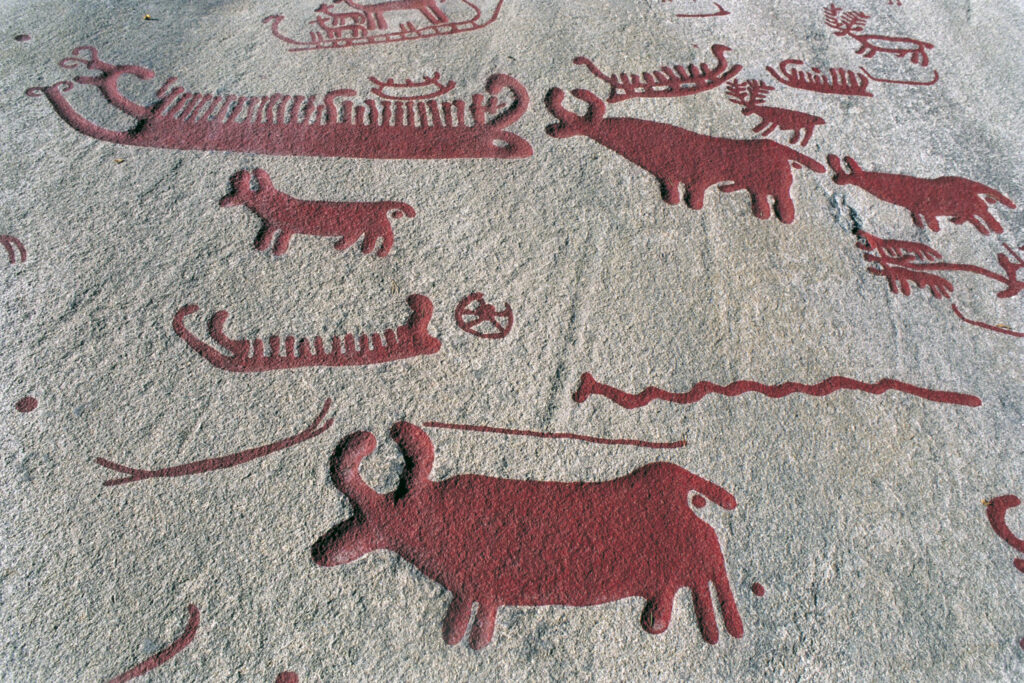
Aside from this, Bronze Age music is indicated by the finds of musical instruments called lurs. A lur is a wind instrument typically formed of one or more tubes of bronze (later periods would make them of wood instead) widening from one end to the other. As with modern brass instruments, the player would blow through the narrower end using the vibration of the lips to generate sound. Lurs feature no finger holes, so pitch was controlled by the blowing itself.
Aside from this, dozens of finds of exquisitely-crafted bronze artefacts attest to the metalworking skill of the Bronze Age Scandinavians and their appreciation for fine art. These were primarily made by casting and molding, including the famous “lost-wax” technique, allowing for fine details.
Drawing to a close
The Bronze Age in Scandinavia marks a clear shift in societal structures, economy, power, and politics which leads to the beginning of a larger segregation in society between the commoners and the elite. These were drastic changes to the Scandinavian world, and they would come to be very consequential later on in the Iron Age. The need to display wealth in a new way gave birth to new burial practices that Scandinavia would later become famous for. The cultural connections opened and maintained by the bronze trade did not only open greater communication with the distant south, but it also started to shape the religious and artistic views of the north.
The Bronze Age was a period guided by the winds of change, and diving into the archaeological material witnesses a period that will be the foundation for millennia to come. The relatively egalitarian Stone Age had ended, and society would never again be the same.
But more changes were on the horizon. Only 500 years after Scandinavia had finally entered the Bronze Age, a new age had begun much further south, with the mastery of yet another form of metal. And while it would take another 700 years still for this new age to dawn in Scandinavia, the society established during the Bronze Age laid the foundations and the template for the coming Iron Age, which would see Scandinavia explode on to the world stage like never before.
Text: Martine Kaspersen. Copyright 2022 Scandinavian Archaeology.
Cover Image: auctionet, Auktionshuset Kolonn.
Further Reading
- Alsaker, S.K. et al. 2005. Trøndelags historie, landskapet blir landsdel fram til 1350. Trondheim: Tapir Akademisk Forlag.
- Clottes, J. 2002. World Rock Art. Los Angeles: The Getty Conservation Institute. ‘’A Mysterious art’’.
- Grønnesby, G. 2009. En reise gjennom liv og død, ild og vann. En bronsealders gravruin i Steinkjer. Vitark 6. (s. 66-77)
- Jensen, J. 2002. Danmarks Oldtid. København: Gyldendal Forlag. (Solens folk (s 273-326).
- Kristiansen, K. 2013. Religion and society in the Bronze Age. I: Christensen, L.B., Hammer, O. & D. Warburton, D.A (eds.) The Handbook of Religions in Ancient Europe. New York: Routledge. (s 77-92).
- Lindström, J. 2022. Sveriges långa historia: människor, makt, och gudar under 14 000 år. Stockholm: Nordstedts.
- Price, T.D. 2015. Ancient Scandinavia: an Archaeological History from the First Humans to the Vikings. New York: Oxford University Press.
